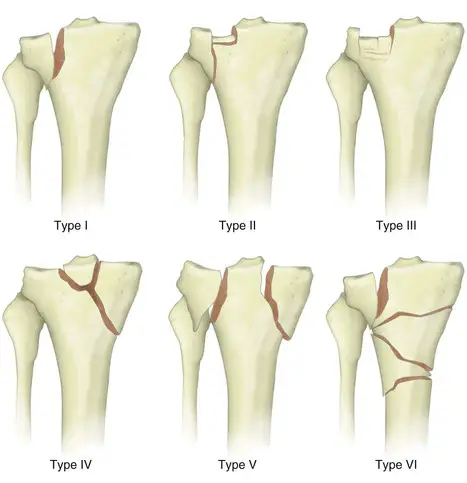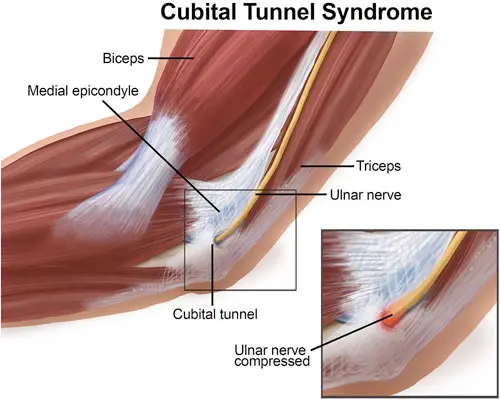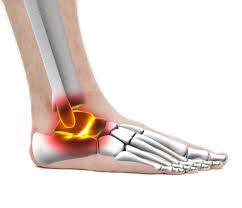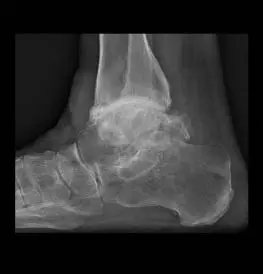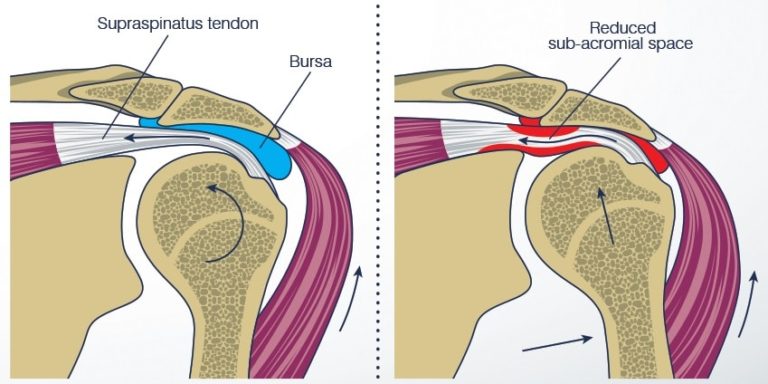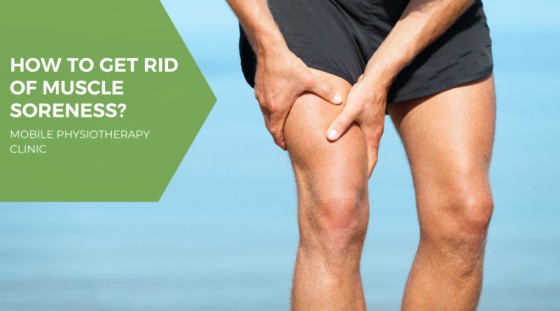How to Relief From Shoulder Pain
Introduction
The shoulder that most people refer to is actually made up of multiple joints that work in tandem with muscles and tendons to give the arm a broad range of motion, from rubbing your back to giving a perfect pitch.
But mobility comes at a cost. It could make the soft tissue and bone structures in your shoulder more prone to instability or impingement, which would be painful. Pain could be felt constantly or just when you shift your shoulder. The pain might only last a short while, or it might persist and need medical attention.
This article describes a few usual causes of pain in the shoulder and offers some general remedies for it. You can get additional details about the shoulder pain from your doctor.
Anatomy
The humerus, or upper arm bone, the scapula, or shoulder blade, and the clavicle, or collarbone, are the three bones that make up your shoulder.
Your shoulder blade has a rounded socket that the head of the upper arm bone slides into. The glenoid is the name of this socket. A web of muscles and tendons keeps your arm bone in the middle of your shoulder socket. These muscles are known as the rotator cuff. They join your shoulder blade to the head of the upper arm bone.
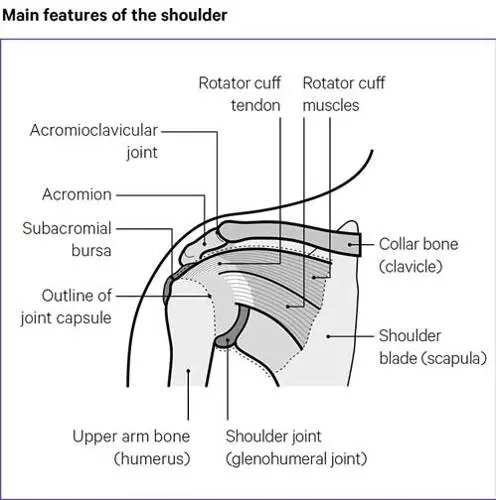
The range of motion in the shoulder is flexible. When a factor goes wrong with the shoulder it can be very painful and restrict your range of motion.
There is cartilage covering these bones to act as a cushion. There are two major joints. The clavicle and the uppermost portion of the scapula meet at the acromioclavicular joint.
The top, ball-shaped portion of the bone known as the humerus and the outside edge of the scapula combine to form the glenohumeral joint (shoulder joint).
The shoulder joint represents the body’s most movable joint. It causes the shoulder to move backward and forward. Additionally, it permits the limb to move both freely and in a circular manner.
The rotator cuff provides the range of motion for the shoulders.
Four tendons make up the rotator cuff. The tissues that join muscles to bones are called tendons. If tendons or bones surrounding your rotator cuff are injured or swollen, lifting your arm above your head may hurt or be challenging.
Playing sports, doing manual labor, or even just moving repetitively can cause a shoulder injury. Some illnesses can cause shoulder pain. These include conditions affecting the liver, heart, or gallbladder in addition to illnesses of the cervical area (neck).
The likelihood of shoulder problems increases with age, particularly beyond the age of sixty. This is a result of the aging process weakening the soft tissues that surround the shoulder.
Shoulder pain is often treatable at home. But other treatments like physical therapy, medication, or surgery might also be required.
Everything you need to know regarding shoulder pain, including its causes, symptoms, diagnosis, and prevention, is provided here.
What are the main causes of shoulder pain?
Several things can cause shoulder discomfort. The most common cause is tendinitis in the rotator cuff.
The hallmark of this ailment is enlarged tendons. Impingement syndrome, in which the rotator cuff becomes lodged between the acromion—the portion of the scapula covering the ball—and humeral head—the ball part of the humerus—is a further prevalent cause of shoulder pain.
Occasionally, injuries to another part of your body typically the neck or biceps cause shoulder pain. We call this referred pain. Moving your shoulder usually doesn’t make the pain worse.
Among the other causes why shoulders are injured are:
- Arthritis
- Ripped cartilage
- Rotator cuff tear
- Swollen tendons or bursa sacs
- Bone spurs, which are bony protrusions that form around the borders of bones
- A nerve that has been compressed in the shoulder or neck
- Shattered arm or shoulder bone
- Froze shoulder
- Displaced shoulder
- Harm brought on by excessive or repeated use
- Spinal cord damage
- Heart attack
Most shoulder issues are localized in nature and should go away quickly.
However, in certain cases, a shoulder issue may be a symptom of a more widespread, chronic illness like polymyalgia rheumatica or osteoarthritis.
People who have rheumatoid arthritis frequently experience shoulder pain and swelling.
Shoulders are less susceptible to osteoarthritis than other joints unless you have a history of injury.
There are numerous additional potential reasons for shoulder pain, including:
- Inflammation is your shoulder’s normal response to a disease or injury and manifests as heat, redness, swelling, and pain
- Injury in the tendons and muscles surrounding the shoulder
- Tension in the muscle groups within the neck and shoulder; is typically caused by improper neck or upper back posture, which is frequently related to how you stand or sit while using a computer or at work.
- Irritation of the bursa, a cushion filled with fluid that normally facilitates the musculature and tendons sliding within the shoulder bones with ease.
- Arthritis may result in harm to the bones and cartilage.
It’s also possible that an issue in another area of your body, like your neck, is the cause of the pain you’re experiencing in your shoulder.
Your upper outer arm or shoulder blade may hurt if you have neck problems. This type of pain is referred to as radiated pain or referred pain. Should you experience tingling in your arm or hand along with shoulder pain, it is most likely the result of a neck issue.
Particular conditions affecting the shoulders
The following are a few particular ailments that can impact the shoulder:
Both calcific Periarthritis and calcific tendinitis
Calcium deposits become embedded in the rotator cuff tendons when calcific tendinitis occurs.
Although the exact cause of these deposits is unknown, some specialists think they could be the consequence of a ligament’s improper healing process.
The illness may cause excruciating pain, which frequently begins in the morning. People with diabetes as well as elderly and middle-aged individuals are more likely to experience it.
The goals of treatment are to reduce pain and maintain the shoulder’s range of motion. Physical therapy, injections of corticosteroids, and anti-inflammatory drugs are among the options.
Your physician might recommend surgery to remove the deposits in the event the pain is serious or persistent.
Sometimes calcium crystals formed inside a tendon can cause pain, swelling, and trouble moving your shoulder. The sturdy cords called tendons connect muscles to bones.
Since calcium strengthens teeth and bones, it is a necessary mineral for all living things. However, if the body has an excess of it, it can occasionally cause tiny, sharp crystals to form in inappropriate places. This is known as calcific tendonitis if it develops in tendons.
The shoulder is one of the many locations in the body where this can occur.
After that, calcium crystals may shed coming from the tendon and result in joint pain and swelling. We refer to this as calcific periarthritis.
Injections of steroids are frequently effective in reducing edema. Nonetheless, keyhole surgery may occasionally be required to remove the calcium deposits.
Adhesive capsulitis, or frozen shoulder
Adhesive capsulitis, also known as frozen shoulder, is a condition where the tissues surrounding the shoulder joint thicken and stiffen.
When you experience a frozen shoulder, your shoulder cannot move because the capsule surrounding the joint has grown too tight. Though it frequently occurs after an injury, heart attack, or stroke, and is more common in individuals with diabetes who are unable to produce enough insulin, the exact cause of this condition is not always known.
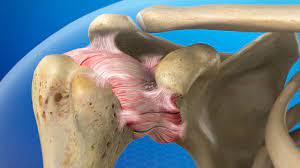
Though it could take up to three years, the condition usually gets better with time.
Particularly at night, you may experience abrupt muscle spasms, which are excruciating pains that can be quite severe. Painkillers might be necessary to help.
Those aged 40 to 60 are usually when it first appears. Women experience frozen shoulders more frequently than men do, as do those who have certain medical conditions like high cholesterol, type 2 diabetes, or thyroid issues.
A tendon tear, rotator cuff impingement, or even a small injury can result in a frozen shoulder. However, it’s unclear why some individuals go on to acquire frozen shoulders.
For a frozen shoulder, a procedure known as volume hydro dilatation is occasionally utilized. This entails the following combined:
- An ultrasound-guided steroid injection into a painful area
- Local anesthetic to cause numbness
- A salt and water solution.
The capsule lining is stretched by injecting this treatment into the shoulder. Although it may hurt a little, the shoulder should feel better afterward. It works for a short while for some people, but most find it to be very helpful.
On its own, a steroid injection or physical therapy may be beneficial.
The majority of patients with frozen shoulder recover completely. If, however, your issue persists after attempting alternative treatments, you might have to think about having surgery.
You will discuss with your physician or physical therapist which procedure keyhole techniques, which loosen the tight capsule surrounding the joint, or surgery, which manipulates the joint will best address your condition.
After treatment, you will need to adhere to an exercise regimen to prevent the issue from recurring. To restore a full range of motion and maintain proper function in your shoulder, it’s critical to perform your exercises on a regular basis.
Osteoarthritis
Osteoarthritis is a prevalent ailment that can impact any joint. However, unless you’ve recently sustained an injury or the cartilage in your shoulder has been subjected to additional stress, it’s more uncommon in the shoulder.
Shoulder osteoarthritis is characterized by a decrease in cartilage and the formation of small pieces of extra bone, known as osteophytes, which can alter the shape of the joint.
This can cause excruciating pain and make it difficult to move your shoulder and arm. Reaching above your head, across your body, or while you’re lying on the afflicted side may hurt.
People often associate osteoarthritis with pain in the knee and hip, both of which are common locations for arthritis symptoms. Although it doesn’t affect the shoulder as frequently, osteoarthritis is still quite common.
The disorder arises from the erosion of the cartilage that cushions the shoulder bones, rubbing the bones against one another.
Osteoarthritis can be treated with a variety of methods, such as corticosteroid injections, anti-inflammatory medications, activity modifications, rest, and in certain situations, surgery.
When osteoarthritis pain strikes, you might be tempted to give up on movement, but this can exacerbate the condition by causing the muscles to shorten and stiffen.
Moving the way that you want to may eventually become even more difficult as a result of this.
Your course of treatment will be determined by how much pain you are experiencing and how it is affecting your range of motion. While physiotherapy can be helpful, painkillers might also be required.
Arthritis can also cause shoulder pain. Arthritis can take many different forms. Osteoarthritis, sometimes referred to as wear-and-tear arthritis, is the most prevalent kind of shoulder arthritis.
In middle age, symptoms like pain, stiffness, and swelling usually start. Osteoarthritis progresses slowly, and as it does, so does the pain it produces.
Osteoarthritis may be brought on by persistent wear and tear, injuries sustained at work or in sports. Some forms of arthritis may be associated with inflammation of the lining of a joint, an infection, or tears in the rotator cuff.
People will often try to minimize their shoulder pain by not moving them. This can occasionally cause the soft tissue components of the joint to stiffen or tighten, which causes a painful range of motion restriction.
You may require an injection of non-steroidal anti-inflammatory drugs (NSAIDs) if you experience a flare-up, in which your condition gets worse out of the blue.
A shot of steroids might be beneficial.
Should non-surgical interventions prove ineffective and your osteoarthritis significantly impair your standard of life, you might want to discuss the advantages and disadvantages of joint replacement surgery with your physician and physical therapist.
Check out our resources on elbow and shoulder replacement.
Rheumatoid Arthritis
An inflammatory form of arthritis that usually affects the hands and feet but can also affect the shoulders is called rheumatoid arthritis.
The synovium, the innermost layer that covers the joint capsule, is affected by inflammation, but over time, the cartilage, bones, and ligaments may also sustain damage.
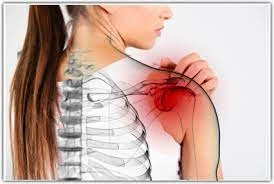
Although there isn’t a cure at this time, there are numerous treatment options. While some of these can stop or slow the progression of the symptoms, others will help to ease them.
People will often try to minimize their shoulder pain by not moving them. This can occasionally cause the soft tissue components of the joint to stiffen or tighten, which causes a painful range of motion restriction.
Rheumatoid polymyalgia
Shoulder and pelvic muscle pain and stiffness are common symptoms of polymyalgia rheumatica. It is particularly severe in the mornings and appears fairly quickly over the course of a week or so.
Try to get in touch with your healthcare provider as soon as you can if you have hip and shoulder pain, fever, or other symptoms of illness. Since polymyalgia rheumatica can lead to other complications like inflammation of the vessels that carry blood in the head, it is best to treat it as soon as possible.
Steroid tablet treatment works well for it; however, a year or longer of treatment may be required.
Neck pain that was referred
If you’ve been told that your shoulder pain is due to referred pain, it might be originating from a neck injury or inflammation.
It is frequently associated with pain that radiates down your arm and a feeling of needles and pins in your hand or arm. Another name for it is radiated pain.
Sometimes the problem is only confirmed when neck physiotherapy treatment resolves the issue; on occasion, you may be referred to a neurosurgeon.
Respiratory ailments
Shoulder pain can occasionally be brought on by lung conditions, such as cancer. If you smoke and are older than 40, your risk of cancer increases.
In the event that your unexplained pain persists for longer than three weeks, your physician might advise a chest x-ray. Additionally, you ought to inform your doctor if you’ve experienced any unknown weight loss or nocturnal sweats.
Tendon issues
Your shoulder’s surrounding tendons may experience inflammation, damage, or pain. These may result in a variety of issues.
Pain in the tendons
The cord that joins muscle to bone is called a tendon. The majority of cases of tendinitis are caused by tendon inflammation.
Tendinitis typically comes in one of two forms:
Acute: Acute tendinitis can result from repetitive overhead activities, such as throwing balls excessively, in sports or at work.
chronic: Chronic tendinitis can result from age-related repetitive wear and tear or degenerative diseases like arthritis.
All four rotator cuff tendons along with the biceps tendon are the most frequently injured shoulder tendons.
The four tiny muscles and tendons that cover and stabilize the head of the upper arm bone in the socket of your shoulder make up the rotator cuff. For stability and shoulder motion, your rotator cuff is essential.
Tendon tear
Tendon splitting and tearing can be caused by a sudden injury, prolonged excessive usage and wear and tear, aging-related degenerative modifications in the tendons, or acute injury.
The tendon’s attachment to the bone may be entirely or partially severed by these tears.
The tendon is torn from its attachment with the bone in the majority of cases of complete tears. Among these injuries, rotator cuff as well as biceps tendon damage are among the more frequent.
Painful arc syndrome or impingement of the shoulder
The upper arm bone is held in place in its shoulder blade socket by a collection of tendons and muscles called the rotator cuff.
Pain resulting from a rotator cuff issue is frequently referred to as shoulder impingement. The rotator cuff tendons become inflamed, painful, or damaged as a result of the condition. Your arm may become difficult and painful to move correctly as a result.
Lifting your arm far above your body can hurt and be challenging, especially if you’re attempting to raise it above your head. You might experience a dull, lingering pain in the upper arm, or your arm might feel weak.
When the arm is raised away from the body, pressure from the acromion, which is the top part of the shoulder blade, presses against the soft tissues beneath, resulting in shoulder impingement.
The acromion “impinges” or rubs against the bursa and rotator cuff tendons when the arm is raised. This may result in tendinitis and bursitis, which would hurt and restrict motion.
The mainstays of medical care for shoulder impingement are rest and physiotherapy. To relieve the pain, your doctor might advise receiving a local anesthetic and steroid injection.
After receiving treatment, if the pain doesn’t go away or returns after a few months, keyhole surgery might be necessary.
Subcutaneous bursitis
Subacromial bursitis results in shoulder pain and swelling. It could be challenging to lift an arm over your head.
When a subacromial bursa becomes inflamed, it is diagnosed. A bursa is a fluid-filled pocket that supports a joint and permits unrestricted bone movement. One specific bursa on each shoulder is referred to as the subacromial bursa.
Bursae are tiny sacs filled with fluid that are found in all of the body’s joints, including the shoulder. They lessen friction between gliding muscles as well as the bone and serve as cushions between the bones and the soft tissues that cover them.
The bursa within the rotator cuff and the acromion, a portion of the shoulder blade, can occasionally become inflamed and swollen due to overuse. The outcome is a disorder called subacromial bursitis.
Rotator cuff tendinitis and bursitis frequently coexist. The shoulder’s numerous tissues can become painfully inflamed. Numerous everyday tasks, like brushing your hair or putting on clothes, could get challenging.
This illness is frequently brought on by overuse or may result from a fall-related injury. It has a connection to the impingement of the shoulder.
NSAID pills or creams, physical therapy, and rest are likely to be part of the treatment plan. Although it is rarely necessary, surgery may be suggested if your condition doesn’t get better.
Rotator cuff tear
Adults over 40 are more likely to have a torn rotator cuff. Many people don’t recall ever injuring themselves. Though it’s not always painful, for some people it takes a few weeks before they experience shoulder stiffness or difficulty moving their shoulder.
It could hurt and be challenging to raise your arm correctly if you’ve torn your rotator cuff, especially beyond shoulder height.

You may lean your shoulders and experience neck pain as a result of your shoulder and neck muscles overcompensating for the absence of movement.
Tendon tears are frequently only discovered following an MRI or ultrasound scan, and the symptoms are comparable to those of shoulder impingement.
There is one more characteristic that sets a rotator cuff tear apart from an impingement: the pain it causes. Should the discomfort be accompanied by weakness, a tear is probably the source; if it’s just pain, a rotator cuff injury could be the only explanation.
If only a portion of an elastic tendon is torn from the bone it’s attached to, this is known as a partial tear. Alternatively, a full tear may occur, in which case the tendon totally separates from the bone.
While rotator cuff tears do occur in younger individuals, they are becoming more prevalent as people age, presumably due to a weakening and increased susceptibility of the tendon-bone interface. with every decade of life, the prevalence increases.
A tear has become more probable to be the result of an injury than impingement. Getting grabbed by a dog on a leash, tripping or landing on your shoulder, and falling on the ice are common causes. In other situations, issues appear out of nowhere. Suddenly experiencing pain when moving something above your head is possible.
See a doctor straight away if you think you may have a tear or are feeling sudden pain of an injury. It might take surgery to fix the problem. However, rest and anti-inflammatory drugs might be sufficient to relieve your discomfort if you’re not weak and the pain isn’t too bad.
Tendonitis in the biceps
The biceps tendon passes through the front portion of the shoulder area joint and is attached by the biceps muscle located in front of the forearm.
Should this tendon become inflamed, extending your arm forward or flexing your elbow will hurt. There’s a chance that your front shoulder hurts too. Biceps tendonitis is the term for this.
Recovering your arm won’t require you to lift it above your head.
To lessen the suffering, try:
- NSAID use
- Applying ice packs to the injured region
- Performing light stretches.
Your doctor might suggest a local anesthetic and steroid injection to relieve your pain if your condition doesn’t get better.
The tendon may occasionally burst, resulting in bruises immediately above the elbow. Your arm and shoulder continue to move normally despite this, but your biceps may bunch. Although it may seem strange, it’s unlikely that the injury will require surgery to be fixed.
Instability
When the upper arm bones are forced out of the shoulder socket, shoulder instability results. This can occur from overuse or from an unexpected injury.
Partial shoulder dislocations occur when the upper arm’s ball only partially separates from the socket. We refer to this as a subluxation. The ball completely pops out of the socket when there is a complete dislocation.
Dislocations can happen frequently if the muscles, tendons, and ligaments surrounding the shoulder become ripped or loose. Partial or complete dislocations that recur hurt and make you unsteady when you elevate your arm or move it beyond your body. A higher probability of developing arthritis is associated with repeated cases of subluxations or dislocations.
Fracture
Broken bones are known as fractures. The clavicle, or collarbone, the humerus, or upper arm bone, and the scapula, or shoulder blade, are frequently fractured in shoulder fractures.
Older patients frequently suffer shoulder fractures as a result of falling from a standing height. Shoulder fractures in younger patients are frequently the result of high-energy injuries, like collisions in cars or injuries sustained during contact sports.
Severe pain, bruising, and swelling around the shoulder are frequently caused by fractures.
Diagnosis
Every shoulder issue has a unique set of signs that can aid in the diagnosis made by a physiotherapist or physician. While most conditions cause pain when using or moving the shoulder, some cause stiffness in the shoulder.
The most painful movements should be noted by your doctor or physiotherapist, as this may indicate the location of the issue. Typically, they’ll want to know how the issue began, how it progressed, and how it impacts your day-to-day activities.
Before your appointment, try to jot down a few notes about the problem, including when it started, how it feels, and what is aggravating it. You’ll receive a more precise diagnosis as a result.
Once your condition has been diagnosed, your doctor or physiotherapist can usually advise on the most appropriate course of action. If they think your issues are related to arthritis or another more serious ailment, they might send you for additional testing.
Which tests should be taken?
Blood tests are rarely required to rule out other conditions, such as certain forms of arthritis, but they are typically not required for the majority of shoulder problems.
X-rays: these are useful for detecting small alterations in the joints and issues with bone structure in your shoulder. Small adjustments, though, are frequently made and might not be the source of your problems.
X-rays are only able to visualize bones and other hard materials; they cannot display injuries to soft tissues, such as muscles
Ultrasound: A diagnostic ultrasound can reveal edema in addition to injury and issues with the shoulder’s muscles, tendons, or other soft tissues. High-frequency sound waves are used to scan and create images of the interior of the body.
Magnetic resonance imaging (MRI): if your physician thinks there may be a more intricate issue involving the soft tissues in your shoulder. Using radio waves, an MRI creates a picture of your shoulder’s soft tissue, including muscles and tendons, as well as its bones.
In order to obtain a clearer image, particularly in situations involving shoulder dislocation, the dye may occasionally be administered to the shoulder prior to the MRI.
Electrical studies: Studies on nerve conduction can determine whether your arm’s pinched or irritated nerves are the source of your problems.
They gauge how active the nerves and muscles are electrically. Although the test doesn’t last long, it’s normal to experience mild pain or discomfort, similar to a tapping sensation on the skin.
Anthropogram: To improve the visibility of the shoulder joint and the surrounding muscles and tendons, dye is inserted into the shoulder during this x-ray study. You could pair it with an MRI.
Arthroscopy: Using a fiber-optic camera, your doctor examines the joint during this surgical procedure. Damage to soft tissues that are not visible on physical examination, x-rays, or other tests may be revealed by arthroscopy. Arthroscopy can be used to treat the issue in addition to assisting in determining the source of the pain.
Treatment to Relief From Shoulder Pain
Analgesics
Basic analgesics like paracetamol as well as non-steroidal anti-inflammatory drugs (NSAIDs) like ibuprofen gels and tablets from the pharmacy or grocery store can be helpful.
You need to be able to get sound guidance from a pharmacist regarding what might be most effective for your condition. However, do not use them for longer than a couple of weeks without consulting a doctor.
Some anti-inflammatory drugs that can help in pain management while decreasing inflammation are available over the counter, meaning they don’t require a prescription. Common home medical kits typically contain medications like aspirin and ibuprofen, which are useful in treating pain from tendonitis, arthritis, and other shoulder injuries.
Numerous topical painkillers, such as gels and creams, can be locally applied to the affected area to relieve pain.
Doctors typically prescribe muscle relaxant medications to treat tension in the muscles and cramps in the joints. They may make you sleepy, but they aid in muscle relaxation and spasm relief.
Therapy with heat or cold
If your shoulder hurts after a small injury or if it’s swollen and feels warmer to the touch than the opposite side, you might want to consider using an ice pack.
To protect your skin, use a package of frozen peas wrapped around in a damp towel. Give it a maximum of twenty minutes to sit in place.
On the other hand, heat packs can be helpful for the majority of other shoulder pain conditions, especially if your muscles are tense and sore.
Reusable heat pads are sold at sports stores and chemists. Alternatively, you could apply a hot water bottle or a microwaveable wheat bag, covered with a dry cloth like a towel, to the sore spot for up to 20 minutes.
An ice pack, icy gel pack, wet cloth, or ice covered in a cloth or just packet is an example of a frozen or extremely cold substance used as a cold compress. By numbing the pain, applying cold compresses helps to reduce shoulder swelling. This simple and effective treatment for shoulder pain is applied when the shoulder region is inflamed. Both store-bought and homemade solutions, including frozen food packets, work well as cold compresses.
Heat is a useful treatment for shoulder pain, particularly when the shoulder is arthritic or has muscles involved. Heat helps tense muscles relax and reduce stiffness, so it can also be used to treat general discomfort and muscle aches. There are several ways to provide heat therapy, including using an electric heating pad, heated gel pack, hot water bottle, or warm towel that has been dipped in hot water.
Posture
Your shoulder issues may worsen if you have poor posture or slouchy working habits.
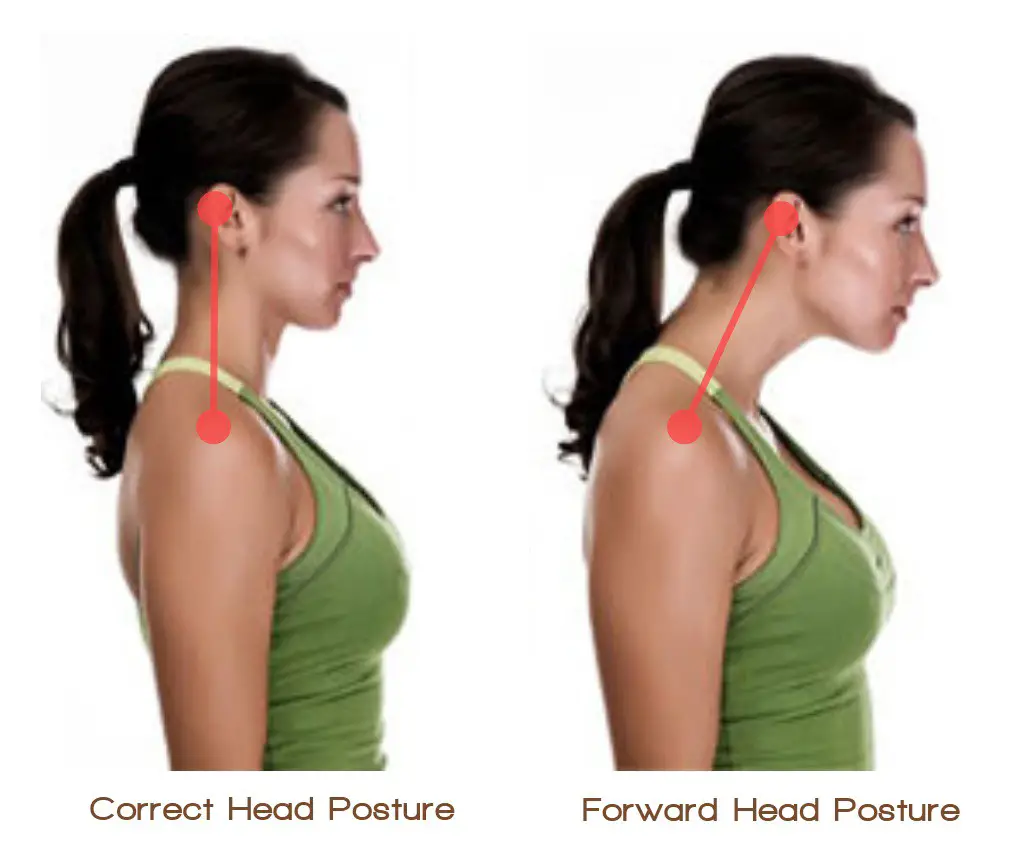
Try these suggestions:
- Steer clear of bending forward and placing too much weight on your arms when seated.
- Particularly if a portion of the pain arises from your neck, try to calm down your shoulders and allow your arms to hang by your sides instead of tightly gripping them.
- Adjust your posture frequently.
- Adopt an erect posture.
- To strengthen your upper body posture, support the back part of your spine with a cushion, pillow, or lumbar support in your chair.
- If you have severe arm pain, place a cushion along with a pillow on your abdomen to provide support and comfort.
- Practice holding the shoulders down and back while looking in the mirror. As you concentrate, picture yourself holding your chest still while pulling your shoulder blades back and downward toward one another.
Try these if lying on your shoulder hurts:
- Resting with a pillow beneath your neck while on the positive side
- putting another pillow under your back to prevent yourself from rolling over your painful side and using a rolled pillow for support for your sore arm in the direction of your body
- If you would rather sleep on your back, place a single or two pillows under the sore arm for support.
Reduce the pressure
In general, it’s advisable to continue as much as possible with your regular activities; just don’t go overboard. You might have to pace yourselves more than normal and make an effort to do a little bit more every day.
You can perform certain tasks a little bit differently to avoid injuring your shoulder.
At home:
- Use short, sweeping motions while vacuuming, keeping your upper body upright and the vacuum next to your body.
- Be sure that the ironing board is set up at waist height and only iron items that are absolutely necessary.
- To transport your purchases, use a backpack or a trolley. Alternatively, you could carry one bag in each hand and split the weight between the two. As an alternative, use long-strapped bags and cross the straps over the body via shoulder to hip. The secret is to distribute the weight of what you wish to carry.
- Seek assistance from your automobile-owning friends by asking them to add any bulky items to their purchasing list.
- If your shopping is large or heavy, use a delivery service.
- Reduce the period of time that you spend sitting and staring down at your phones and tablets. To lessen neck strain, use a stand on the table instead.
- Give yourself sufficient time and ask for someone to assist you if the work requires you to raise your arms or perform sweeping motions. Try to rotate between jobs and positions and take frequent breaks.
At the office:
- Whether you’re standing or sitting, try to keep your posture straight. Steer clear of rigid or twisted neck positions.
- Try to get to your feet and move around occasionally if you are sitting or standing at a workplace, such as a working surface or workbench. To prevent your neck and shoulders from becoming stiff and sore, try gently moving them through their entire range of motion on a regular basis.
- Keep the monitor and keyboard in the direction of you when using a computer to avoid having to twist or turn your head. To avoid having to reach for the mouse, keep it close at hand.
- You may be able to maintain a good working posture by investing in a good chair that can be modified to suit your needs and provides adequate support. Your manager or an occupational wellness advisor might be able to assist you with this.
- Don’t place the phone receiver against your head along with your shoulder while using it. Use a phone headset if you spend a lot of time on the phone.
- Steer clear of any manual labor that causes you pain while doing it.
You need to be able to get assistance from your human resources office or line manager. There may be a professional health department at some companies that can offer you guidance and assistance.
You can also get in contact with advisors who specialize in helping people with physical challenges at work by calling your nearby Jobcentre Plus office. Check out our resources for managing joint pain and arthritis.
If a medical condition has been diagnosed, the employer is legally obligated to modify your work schedule and workspace in a way that will enable you to perform your job duties.
Relaxation and physical activity
Even if you don’t think you can accomplish much, it’s still important to be active. Striking a healthy balance between rest and activity should help prevent your shoulder from stiffening up. Here are some shoulder exercises that may be of assistance.
Steer clear of movements that cause severe pain. It’s best to try to prevent movements such as this as much as possible until they become less painful. Raising your arm beyond your shoulder or maintaining it away from your body’s surface can be extremely painful.
Should you need to raise your arm, the following will lessen the pressure on your shoulder:
- Bending and maintaining the elbow by your side
- When reaching up, keep your palm pointing to the ceiling.
- Bending your elbow will allow you to lower your arm and bring your hand nearer to your body.
Exercise may feel more comfortable for you after applying ice to the shoulder or taking medication. In order to prevent burns or skin irritation, always remember to cover ice with a damp towel.
Complementary treatments
Some people find that their shoulder pain is relieved by a variety of complementary therapies. Some, like acupuncture, are provided by the NHS. However, because there isn’t enough proof to support their efficacy, the NHS generally doesn’t advise complementary therapies.
Treatments that complement medicine are generally safe. However, you should always consult your doctor before using these individuals in case they conflict with any medications you are currently taking.
Make sure the therapist or provider has an approved ethical code, is ethically registered, and has full insurance before beginning any therapy or treatment. We have more details about what to anticipate from complementary and alternative therapists as well as the organizations that regulate practitioners of complementary therapies.
You should evaluate whether or not complementary therapies are improving your condition before determining whether to continue using them, as you will almost certainly be responsible for their cost.
In addition to conventional treatments, we offer information on acupuncture, aromatherapy, manipulative therapies (like osteopathic or chiropractic care), supplements, and much more.
Physiotherapy treatment
Physiotherapy is beneficial for most shoulder issues.
Physiotherapists are experts who can use various strengthening and stretching exercises, massage, and other therapeutic techniques to help you manage your shoulder pain and improve the way your shoulder functions.
Together, you will seek to alleviate your symptoms and restore proper movement to your shoulder. Whether your issue is a transient or chronic condition will determine what they recommend for you.
Nearly everyone will gain from physiotherapy, which employs techniques like:
- Exercises to improve function, alter coordination, and strengthen weak muscles
- Suggestions for better posture of the shoulders, neck, and spine
- Workouts to reduce or avoid stiffness
- Exercises to broaden the range of motion in your joints
- Applying tape with adhesive to the skin to help improve awareness of the location of your shoulder and blade of the shoulder and to lessen the strain off the tissues
- Manual therapies, such as massage therapy and manipulation, for the joints and soft tissues.
Although it might take some time, your doctor can recommend a physiotherapist to you. In certain places, you can also make the referral on your own.
If you go privately, you could see one more quickly, but the cost would be incurred. The Chartered Community of Physiotherapy website has details on private physical therapists in your area.
Easy shoulder stretches
- Stretching your shoulders while seated
mainly extends the shoulder
Reps: 2-4 Hold for ten to thirty seconds.
Beginning posture: Take a seat upright in a chair. Position the left hand over the right shoulder. Using your right hand, cup your left elbow.
Movement: Extend your left arm and roll your shoulders back and down. Gently bring the left side of your elbow across your chest. Notice how your left shoulder is strained. Pause. Return to your previous location and continue on the opposite side. One rep is awarded for this. This counts as one rep.
- Stretching your triceps while seated
primarily stretches the shoulder and the back along with the upper arm
Reps: 2-4 Hold for ten to thirty seconds.
Starting posture: Take a straight seat. Using your right hand, grasp your right shoulder. Using your left hand, grasp your right elbow.
Movement: Raise your right elbow toward the ceiling until it becomes taut while maintaining a back-and-down posture. The back along with your upper right arm with shoulder should feel stretched. Pause. Go back to where you were before. Continue on the opposite side. This counts as one rep.
- stretch your chest while seated
mainly stretches the shoulders and chest
Reps: 2-4 Hold for ten to thirty seconds.
Starting posture: In an armless chair, sit up straight and face sideways.
Movement: Roll your shoulders back and down in motion. With your fingers intertwined and your palms facing you, clasp both hands behind your back. Till your hands become taut, gently raise them toward the ceiling. Sensate the stretch across your chest and in the front part of your shoulders. Pause. Return to the position of beginning slowly.
Shoulder exercises
Regular shoulder exercises and stretches help build stronger shoulder muscles and reduce pain. It is essential to perform these stretches and exercises correctly to prevent making the shoulder issue worse. When you visit an orthopedic physician for shoulder pain, they may recommend exercises and the right amount of repetitions to help you manage your shoulder pain conveniently in the comfort of your own home. After a sufficient warm-up, one must begin these mild exercises and cease right away if the pain worsens. Several exercises can help relieve shoulder pain and build strong, flexible shoulder muscles. These include:
- Stretching a pendulum
- Stretching the shoulders overhead
- Stretching across the chest
- Release of the neck
- Expansion of the chest
- Circles of the shoulders
- Dog posture in the downward position
- Child’s position
How to avoid having shoulder pain?
Along with performing these types of exercises, you can avoid shoulder pain by adhering to a few basic rules and recommendations:
- Maintain proper posture when standing, sitting, and going about your everyday business to prevent slouching or hunching over.
- Throughout the day, keep an eye on how you’re carrying your body and make any necessary adjustments.
- Rest well and avoid engaging in any painful activities for a while.
Exercise caution when performing tasks that require you to bend forward, carry heavy objects, or reach up. If your job requires you to perform these tasks, consider how you can stretch your body to reduce discomfort.
Make sure you’re using the correct technique and form if you perform sports that result in shoulder pain.
Summary
Even though shoulder pain is frequent, it can be avoided and managed. Regularly perform these exercises to help prevent and relieve shoulder pain.
You can treat your own shoulder pain by experimenting with home remedies. Even after you start to feel better, keeping up with the physical activity and treatments will help keep the pain from returning.
Consult your physician prior to beginning any exercise regimen if you have any potentially affecting medical conditions.
- Rest: It’s critical to avoid activities that make the pain worse.
- Ice: For twenty minutes at a time, putting on ice the afflicted area can help lessen
- Pain and inflammation.
- Heat: Using heat on the injured area can help promote flexibility and blood flow.
- Painkillers: Ibuprofen and acetaminophen, two over-the-counter painkillers, can help lessen pain and inflammation.
- Physical therapy: physiotherapy can help increase flexibility and strengthen the shoulder musculature.
- Corticosteroid injections: Although they aren’t a long-term solution, corticosteroid injections may reduce pain and inflammation temporarily.
FAQs
What could result in an extremely painful shoulder?
The most frequent reason for shoulder pain is inflammation or imprisonment of the rotator cuff tendons in the shoulder. This is known as rotator cuff tendinitis, which is an irritation of the tendons and a swelling of the bursa, which are tiny, slick sacs filled with fluid that the tendons pass through.
What is the quickest method for getting rid of shoulder pain?
Utilize both cold and hot therapy and painkillers.
To relieve pain and inflammation, place an ice pack wrapped in a damp towel over your shoulder and leave it there for approximately twenty minutes every few hours. Apply a heat pack or wrapped hot water bottle to your shoulder several times a day for about 20 minutes to release tense or achy muscles.
What is a shoulder pain cure that is natural?
Apply heat using a hot pack or heating pad. There should always be a layer between your skin and the pad. For fifteen to twenty minutes, use ice. Pain and swelling have been demonstrated to be reduced by salt bathing.
Is it appropriate to massage shoulder pain?
Moving your arm can be challenging if you have a dislocated shoulder or torn rotator cuff, but so can spending too much time sitting still. A shoulder massage can help you extend your range of motion regardless of what is causing your stiffness or soreness.
Does shoulder pain improve with physiotherapy?
With the use of their expertise, a physiotherapist can assist in relieving your shoulder ache and helping you resume your favorite activities. Don’t let yourself suffer needlessly—there are many ways to lessen discomfort while you wait for things to heal themselves!
Reference
- Shoulder pain. (n.d.). Versus Arthritis. https://versusarthritis.org/about-arthritis/conditions/shoulder-pain/
- Shoulder Pain and Common Shoulder Problems – OrthoInfo – AAOS. (n.d.). https://orthoinfo.aaos.org/en/diseases–conditions/shoulder-pain-and-common-shoulder-problems/
- Ouch! Shoulder pain and how to treat it. (2022, August 9). Harvard Health. https://www.health.harvard.edu/pain/ouch-shoulder-pain-and-how-to-treat-it
- Seo, M. (2022, June 24). 5 Easy Ways to Deal with Shoulder Pain | Medanta. Medanta. https://www.medanta.org/patient-education-blog/5-easy-ways-to-deal-with-shoulder-pain
- Cronkleton, E. (2023, February 3). Top 10 Exercises to Relieve Shoulder Pain and Tightness. Healthline. https://www.healthline.com/health/shoulder-pain-exercises
- Pietrangelo, A. (2023, May 22). Why Does My Shoulder Hurt? Healthline. https://www.healthline.com/health/chronic-pain/shoulder-pain


